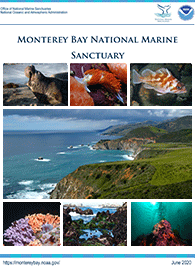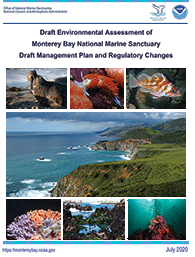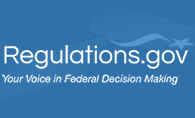MBNMS Management Plan Review
GENERAL INFORMATION
NOAA's Office of National Marine Sanctuaries has revised the management plan for Monterey Bay National Marine Sanctuary. The prior plan was issued in 2008.
Over the last decade, the sanctuary's natural and cultural resources and environmental conditions have changed, creating new challenges for protecting resources and facilitating compatible use. At the same time, new tools for effective management have emerged, driven by scientific advances, technological innovation, and new partnerships. An evaluation of requirements and approaches, both current and future, ensure we, and our partners, are making the most effective use of programmatic resources.
Public engagement is central to NOAA's community-based approach to managing sanctuaries. We are soliciting public input on the draft management plan, the draft environmental assessment and the proposed rule at this time. You may submit comments during public comment periods and view comments submitted under docket number NOAA–NOS–2020-0094 at Regulations.gov.
 |
 |
 |
| DRAFT Management Plan | DRAFT Environmental Assessment | Federal Register Notice and Proposed Rule |
At A Glance – brief summaries
Draft Action Plans • Draft Assessment • Proposed Regulation Changes
Draft Action Plans at a Glance
The following action plans will be revised as part of the management plan review process. To learn more about the activities proposed, see the Draft Plan.
Issue-based Action Plans
Climate Change
Goal: Address coastal resilience, climate adaptation and ocean acidification through capacity building and collaborative partnerships.
Action Plan Strategies:
- Address coastal resilience and adaptation planning through vulnerability assessment workshops and the development of a Climate Adaptation Plan.
- Conduct annual inventories from sources such as MBNMS operated facilities, cars, and other transportation to reduce emissions and improve energy efficiency, waste management, and water management when possible.
- Communicate ocean-climate impacts through education and interpretation while providing solutions to address issues such as ocean acidification, sea level rise, and strengthening coastal resilience.
- Implement Coastal Regional Sediment Management Plans to restore, preserve and maintain coastal beaches, enhance sustainable recreation and tourism, enhance public safety and access, and identify areas that could benefit from restoration.
- Track and collaborate on ocean acidification research with partners to monitor changes in ocean pH and effects on organisms and promote sharing of data and information.
| TOP |
Coastal Erosion and Sediment Management
Goal: Reduce human-caused coastal erosion and collaborate with local, state and federal agencies to address and restore sediment balance in nearshore habitats throughout the sanctuary.
Action Plan Strategies:
- Support management strategies on Coastal Regional Sediment Management Plans (CRSMPs) for MBNMS that provide options for site specific measures to restore, preserve, and maintain coastal beaches.
- Collaborate on a land management plan for the CEMEX site that balances commercial use with public access and use.
- Affect the loss of Elkhorn Slough habitat through supporting the Elkhorn Slough National Estuarine Research Reserve’s efforts to monitor and reduce erosion in the slough.
- Implement site specific beach nourishment programs to allow for the beneficial reuse of clean and suitable dredged material for restoration purposes within MBNMS.
- Coordinate with regulatory agencies to determine appropriate disposal of dredge material.
- Track and reduce coastal armoring where appropriate.
- Reduce impacts to sanctuary resources due to landslides and subsequent emergency responses.
- Reduce impacts to sanctuary resources due to anthropogenic coastal changes to river mouths.
| TOP |
Davidson Seamount Management Zone and Sur Ridge
Goal: Increase understanding of the Davidson Seamount Management Zone and Sur Ridge through characterization and ecological process studies and develop education programs for the seamount, the ridge, and similar geologic features throughout the nation.
Action Plan Strategies:
- Conduct site characterization studies that include geological, biological, zoological, oceanographic, and socioeconomic surveys.
- Conduct ecological processes investigations to determine the causes of distribution and abundance of species.
- Conduct seamount education and outreach initiatives to increase the public’s awareness and understanding of these deep-sea environments.
| TOP |
Emerging Issues
Goal: Develop a system to identify, track and appropriately respond to emerging issues presenting high public interest and/or potential threats to MBNMS resources.
Action Plan Strategies:
- Identify and track emerging issues in order to prevent harm to sanctuary resources.
- Develop process to address emerging issues in order to determine the importance and priority of unforeseen issues that may pose a threat and must be understood and addressed in a timely manner.
| TOP |
Introduced Species
Goal: Prevent the introduction, spread, and establishment of introduced species and control and/or eradicate populations of introduced species already established in MBNMS.
Action Plan Strategies:
- Manage pathways and promote prevention of introduced species into the sanctuary.
- Promote early detection and rapid response to be able to quickly assess the threat posed by a newly introduced or newly identified species when new introductions do occur.
- Implement eradication or control measures and long-term management.
- Sustain research and monitoring to improve the knowledge of existing introduced species in MBNMS, population changes by introduced species and their ecological effects.
- Implement restoration of habitats and communities altered by introduced species or the effects of their eradication and control with partners.
- Implement long-term monitoring and extensive mitigation of non-native species in Elkhorn Slough with partners.
| TOP |
Marine Debris
Goal: Assess and reduce the amount of marine debris in or entering Monterey Bay National Marine Sanctuary.
Action Plan Strategies:
- Assess scope and scale of marine debris impacting sanctuary resources.
- Foster public participation and supporting policies leading to reduced marine debris (focusing on plastic pollution).
- Reduce marine debris threats by removing the debris and preventing point source inputs
| TOP |
Water Quality Protection
Goal: Raise awareness of water quality issues in the watersheds and to improve the quality of water entering and within Monterey Bay National Marine Sanctuary.
Action Plan Strategies:
- Facilitate and coordinate regional efforts to improve water quality through the Water Quality Protection Program committee, Agriculture Water Quality Alliance, stormwater programs, and Integrated Regional Water Management programs.
- Understand how runoff from land affects sanctuary resources to effectively prioritize efforts to minimize the threats to MBNMS resources.
- Quantify effectiveness of management practices in improving water quality.
- Monitor and reduce pollutant loads flowing into MBNMS.
- Promote public engagement and stewardship through citizen science monitoring and other Water Quality Protection Program efforts.
- Communicate findings of projects and monitoring conducted by the Water Quality Protection Program.
| TOP |
Wildlife Disturbance
Goal: Maintain and improve protection of wildlife within the sanctuary by evaluating and remediating adverse impacts from human activities.
Action Plan Strategies:
- Mitigate wildlife disturbance from marine vessels and shore-based activities.
- Mitigate wildlife disturbance from aircraft.
- Develop acoustic baseline profiles within MBNMS.
- Reduce underwater low-frequency mechanical sound emissions.
- Use administrative methods to reduce wildlife disturbance.
- Use law enforcement resources to reduce wildlife disturbance.
- Reduce the risk of wildlife entanglement in fishing gear.
- Respond to wildlife entangled in fishing gear.
| TOP |
Program-based Action Plans
Education, Outreach and Communication
Goal: Increase protection and appreciation of sanctuary resources by building greater public understanding, engagement and stewardship throughout our highly diverse coastal communities.
Action Plan Strategies:
- Coordinate education programs through sanctuary visitor centers.
- Enhance sanctuary interpretation and outreach programs.
- Promote public engagement and stewardship through citizen science monitoring programs.
- Maintain and develop sanctuary-wide exhibits and interpretive signage.
- Foster and promote government and community relations.
- Increase awareness through effective media and communication tools.
- Engage in local, regional, and national collaborations to leverage education and outreach opportunities.
- Evaluate effectiveness of sanctuary education and outreach efforts.
| TOP |
Marine Spatial Planning
Goal: Improve conservation science and resource protection and management on select site-specific issues through the application of marine spatial planning principles.
Action Plan Strategies:
- Implement Sanctuary Ecologically Significant Areas (SESAs) that encompass remarkable, representative and/or sensitive marine habitats, communities and ecological processes.
- Track and monitor vessel traffic compliance.
- Collaborate on fishery management issues.
- Determine environmental impact threats from motorized personal watercraft and relevance of the existing operational zones.
- Coordinate regionally, nationally, and internationally on Marine Protected Areas (MPAs).
- Track and monitor of aircraft for compliance within the four NOAA regulated overflight zones.
- Track and respond to offshore wind and wave energy proposals.
- Initiate assessment for the use of artificial reefs for recreation, restoration, or other uses in the sanctuary.
- Monitor and assess golf ball deposition and remediation efforts associated with errant golf ball deposition to the sanctuary from area golf courses.
| TOP |
Maritime Heritage
Goal: Identify, protect, and raise awareness of the maritime cultural, historical, and archaeological resources in MBNMS.
Action Plan Strategies:
- Inventory and assess submerged sites.
- Conduct threat assessments for shipwrecks and submerged structures.
- Protect and manage submerged archaeological resources.
- Develop maritime cultural landscape-focused education and outreach programs.
| TOP |
Operations and Administration
Goal: Address the necessary operations and administration activities required for implementation of an effective program, including identifying staffing, infrastructure resource needs and operational improvements.
Action Plan Strategies:
- Management of MBNMS budget.
- Support Management Plan priorities.
- Coordinate and support Sanctuary Advisory Council.
- Support technical requirements of MBNMS staff and facilities.
- Oversee MBNMS facilities.
- Facilitate field operations.
- Provide general administrative support.
- Administer human resources.
Research and Monitoring
Goal: Assess changes in species, habitats, and processes and participate in regional research and monitoring to better characterize and understand the sanctuary ecosystem, and support ecosystem management, resource protection, and education.
Action Plan Strategies:
- Characterize biological and physical features.
- Maintain and expand the Sanctuary Integrated Monitoring Network (SIMoN).
- Support science focused on priority sanctuary needs.
- Facilitate the flow of science information among academic institutions, government agencies, and other institutions.
- Coordinate with and participate in implementing research components of the Office of National Marine Sanctuaries West Coast Regional Office.
- Coordinate with and participate in implementing policies and programs of the Office of National Marine Sanctuaries Conservation Science Program.
- Interpret select technical science information.
| TOP |
Resource Protection
Goal: Maintain and improve the sanctuary’s natural biological and ecological processes by evaluating and addressing adverse impacts from human activities on sanctuary ecosystems.
Action Plan Strategies:
- Continue to build partnerships and leverage opportunities for protecting sanctuary wildlife, habitats, qualities and cultural resources through collaborative planning and management.
- Enhance socioeconomic program.
- Maintain and enhance permitting and environmental review program.
- Review projects, plans, and permits of other agencies.
- Implement enforcement programs.
- Interpret and distribute resource protection information.
- Coordinate resource protection programs including interpretive enforcement and citizen science programs.
- Coordinate with and participate in implementing resource protection components of the Office of National Marine Sanctuaries West Coast Regional Office.
- Coordinate with and participate in implementing policies and programs of the Office of National Marine Sanctuaries.
- Review and revise the sanctuary’s spill response plan and emergency response information.
- Develop and implement restoration and recovery plans to address habitat damages and endangered species.
| TOP |
